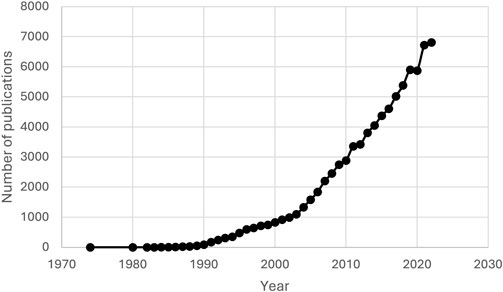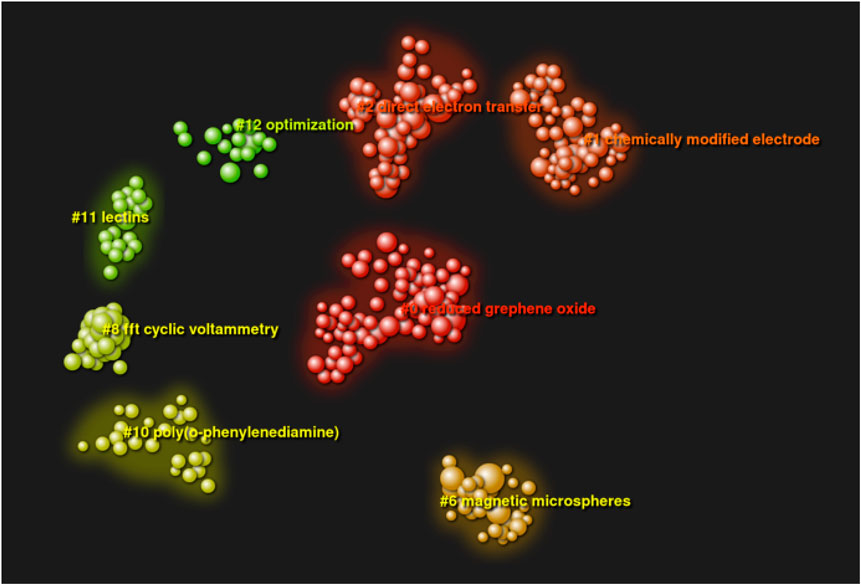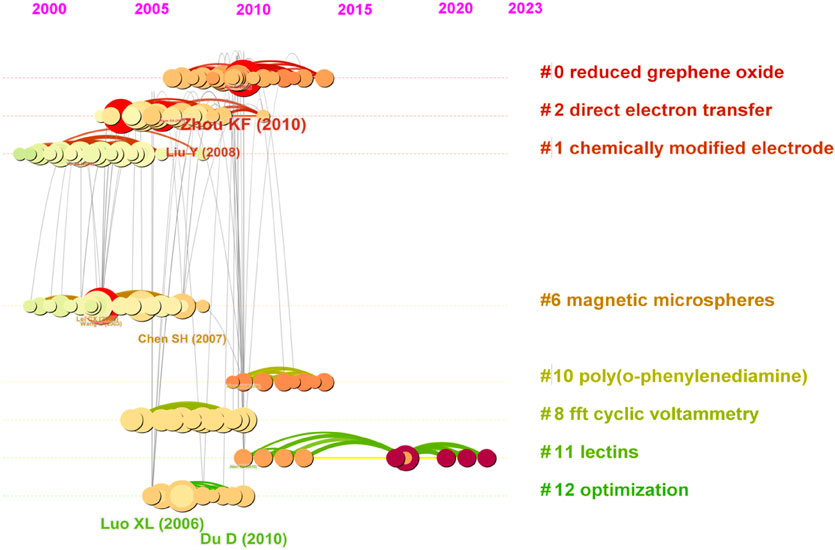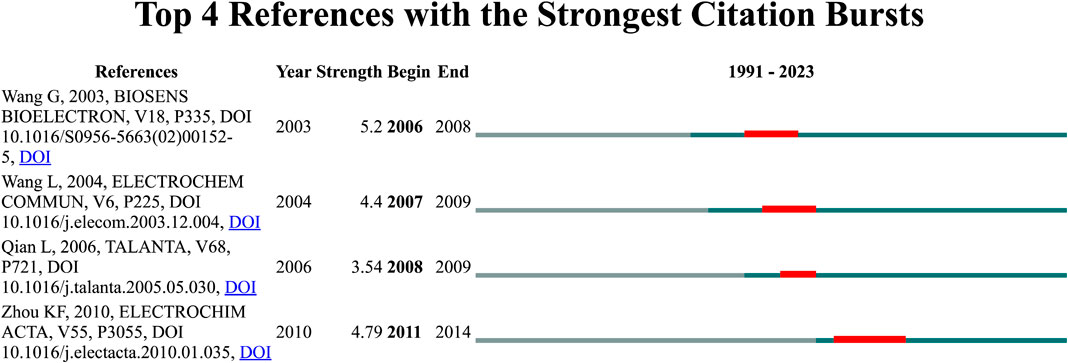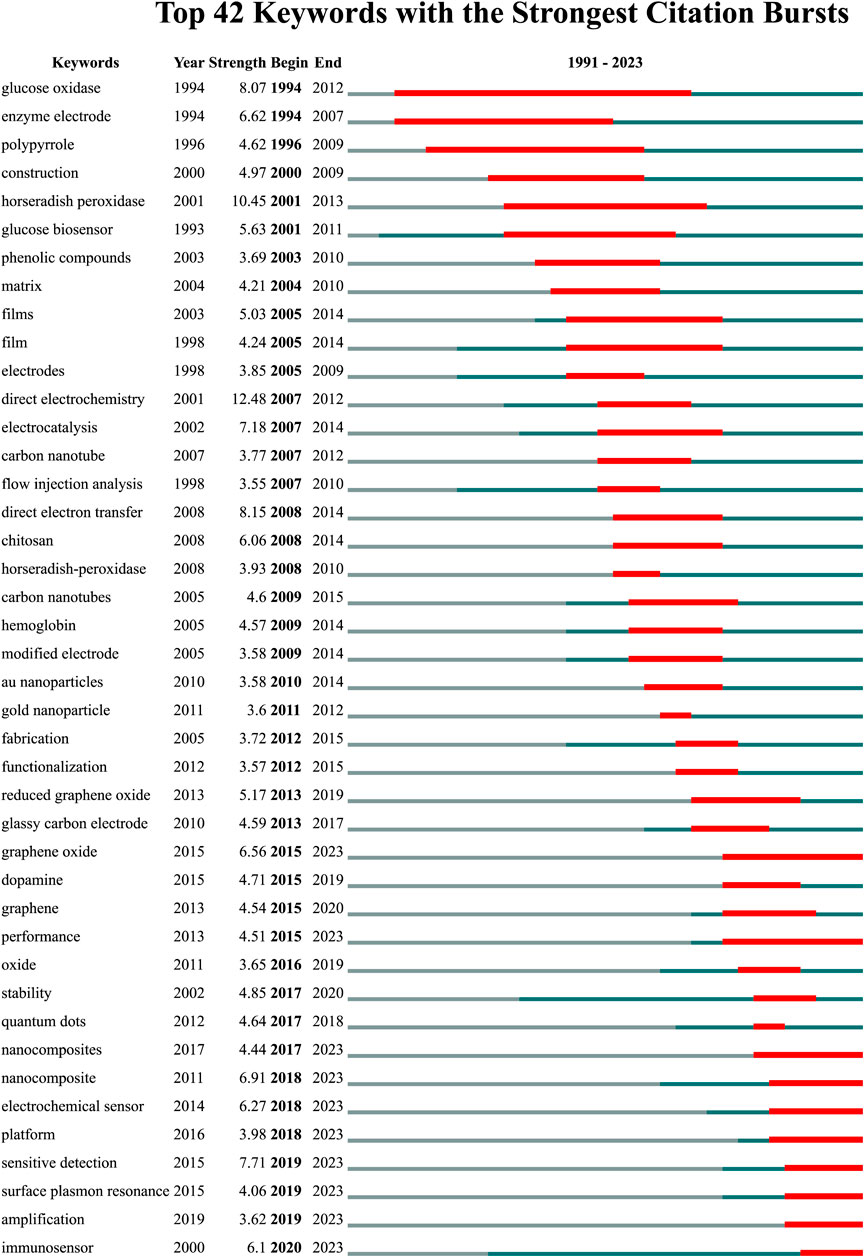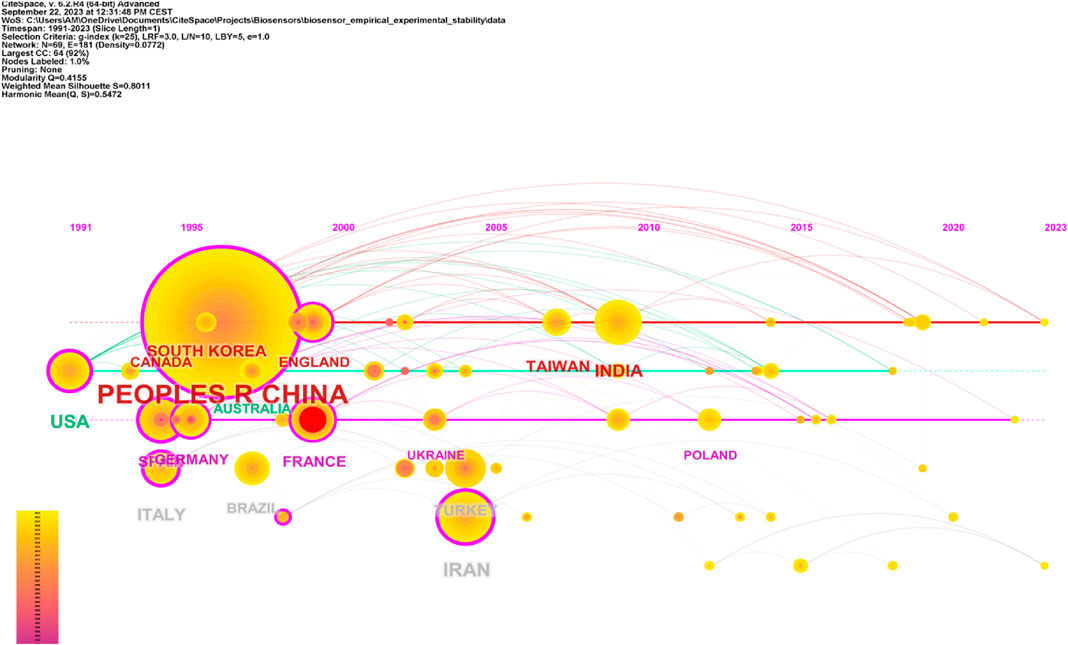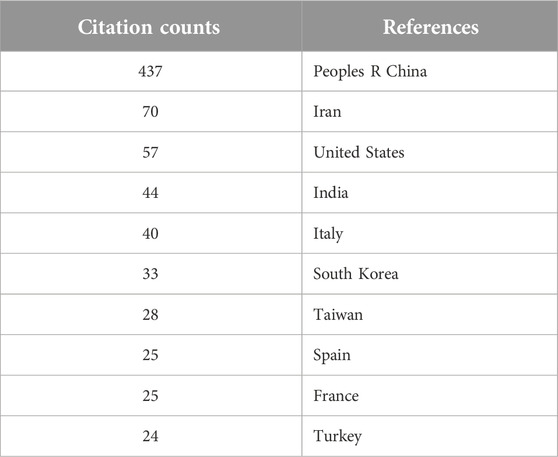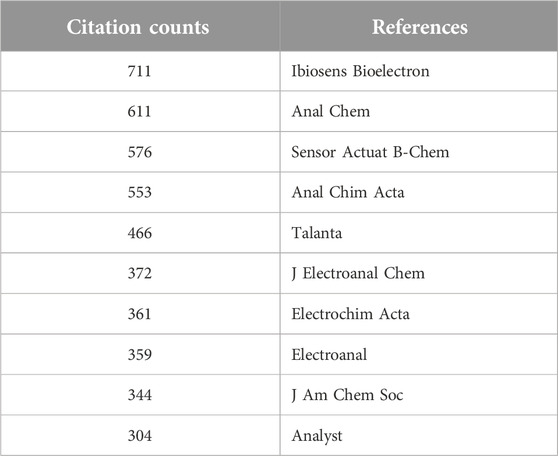- Department of Computer Science and Automatics, University of Bielsko-Biala, Bielsko-Biala, Poland
In the presented work, advanced methods of analysis and visualization were used to compile trends and patterns in the scientific literature. The most relevant information for the stability of biosensors was selected on the basis of clusters constructed on the basis of keywords. The most significant publications in the clusters appearing over time were analyzed. The most explosive publications were identified, i.e., those that have had the greatest impact on science in the area of the subject under study. The scientific trend in the development of biosensor stability was determined on the basis of the most frequently cited words in recent publications. A map of cooperation and networking between countries in the field of interest of the above topic was presented. Leaders were identified by country of origin.
Systematic Review Registration: https://ubb.edu.pl.
Introduction
The number of scientific publications increases every year with the development of technology and the progress of civilization. Therefore, the need for a fast and accurate analysis of the literature to keep track of the development of existing research topics and emerging news in the world of science was naturally born. Previously used scientific analysis based on web reviews or studying scientific databases such as Web of Science, Scopus, PubMed allowed only retrospective analysis, i.e., chronological, recollective analysis without the ability to trace connections. Domain map analysis means the use of graph network representations of the source analysis, including the analysis of the relationships between data with the help of the choice and appropriate distance measure, clustering, mapping the relationships into graph nodes and edges. It allows us to determine the most significant resources analyzed temporal development of the area determined tendencies (Liu et al., 2020; Geng et al., 2023).
One of the most popular tools for bibliometric analysis of domain maps is CiteSpace, which is based on data mining, a process involving data extraction, pattern analysis and sorting. It is a process that can be compared to mineral processing, where the mineral must first be extracted, then cleaned and finally sorted. Data mining enables rapid predictions and classifications to be made and facilitates decision making.
CiteSpace is a Java based application designed to analyze and visualize trends and patterns in the scientific literature to present the structure and distribution of scientific knowledge. It focuses on finding critical points in the development of a field or region, especially intellectual turning points (Xu et al., 2022; Gao et al., 2023; Zhao et al., 2023). In presented papers we used CiteSpace to group keywords and highlight results related to biosensors stability.
The analysis is based on the theoretical trend (intellectual) and the experimental trend. The intellectual trend is based on articles presenting research findings or a scientific point of view, while the experiential trend [as conceptualized by Price (1965)] is based on collections of cited articles.
The functions of the CiteSpace application are based on three central concepts:
1. The Kaliberg crack detection algorithm (Kleinberg, 2002), which is used to identify test concepts.
2. The Freman intercentricity matrix, used to highlight potential key points
3. The Heterogeneous Network, used to map between the intellectual base and the experimental front.
Mapping can be used to identify the nature of the research front, highlight specializations and identify emerging trends over time.
The CiteSpace analysis are based on select single words or phrases of up to four keywords from titles, abstracts and article descriptions based on articles by the method LSI (Latent Semantic Indexing) related to biosensors stability.
The research is based on a surge in citation frequency. Analysis by cluster view and by temporal variation is possible. The CiteSpace tool makes it possible to follow in real time the development of new fields of knowledge and the links in the existing field of knowledge (between institutions and countries), it also gives the possibility to see the history of the emergence of a scientific question and the impact of the main discoveries on the final view. The present article analyses the stability of biosensors on the basis of experimental studies. The analysis was carried out using the CiteSpace 6.2. R4 tool, which selects the most important articles that cause the scientific development of the topic, based on the keywords that appear most frequently in the titles and abstracts. The novelty of the article is: 1) the presentation of the latest trends, the indication of the direction of research in the field of stability of biosensors, based on an advanced analysis using the CiteSpace tool, 2) the identification of the scientific leaders dealing with the studied issue, and 3) the presentation of the mutual network of scientific links between research groups coming from different countries.
Methods
Sources of data
In this paper we used the Web of Science (WoS) database as a data source and through advanced search (TS= biosensor) we obtained 86,814 papers in the range time (01.01.1974–01.07.2023).
Figure 1 shows the number of publications in the field of biosensors from 1974 to 2022. We have chosen 2022 as the upper limit of the time frame because this is the last full calendar year in the WoS database (2023—not yet over). The graph shows a clear increase in publications over time, indicating a growing interest in biosensors, most likely related to the increase in environmental pollution (Pohrebennyk et al., 2018) and the widening range of biosensor applications [medicine (Grabowska et al., 2014), environmental protection (Klos-Witkowska, 2016), food industry (Dirpan et al., 2023) and the drive to improve existing devices to achieve even better detection quality (Laad and Ghule, 2022)]. It is worth noting the slight decrease in the number of papers published in 2020 (5,875 papers) compared to 2019 (5,902 papers), perhaps due to the impact of the COVID-19 pandemic, which was felt all over the world.
Current research is carried out in two parallel streams: experimental and theoretical.
In the experimental stream, work focuses on improving the quality of detection and the stability of the device (Klos-Witkowska and Kajstura, 2020), while the theoretical stream revolves around the development of mathematical models (Martsenyuk et al., 2021b), often using already existing solutions for this purpose (Martsenyuk et al., 2021a), also recently, the interest of scientists in combining biosensors with artificial intelligence has been noted. An extremely interesting issue is the problem of stability in biosensors, which is a very important problem not only from a scientific point of view, but also from a commercial point of view. The stability of biosensors directly translates into the longevity of use and the ability to operate the device. Therefore, following the latest scientific trends, the issue of biosensor stability was chosen to be analysed in biosensor development based on advanced analytics using CiteSpace 6.2.R4;
(1) Identifying the most important (so called “explosive articles”) that generated the most interest among researchers based on their citability.
(2) The most relevant keywords (most cited) in the titles and abstracts were identified and clustered, i.e., grouped according to their relevance.
(3) The most important clusters were described.
(4) The keywords with the highest number of citations on a time scale were visualised.
(5) Identified scientific leaders working on stability issues in the field of biosensors and showed the network of scientific links between research groups from different countries.
Analytical method characteristics
We conducted a literature search using the following search strategy using Web of Science Advanced Search: Publication dates were from 01.01.1974 to 01.07.2023 and search criteria were: for biosensor stability (experimental research): [TS=(biosensor)] AND [TS=(stability)] AND [TS=(empirical)] OR [TS=(experimental)] in the Web of Science Core Collection.
We created visual graphs of keyword co-occurrence, keyword clustering and scientific collaboration using CiteSpace 6.2 R4 software. We investigated the current status and trends in the stability of biosensors.
Results
Biosensor stability
Biosensors are devices that are susceptible to ageing; this phenomenon can be characterised as a decrease in signal over time.
Stability of biosensors is critical for commercial success as biosensors are now used in an increasing number of different applications. Characterisation of stability in terms of shelf life, reusability and the ability to be used continuously is inadequate, although much work has been done in this area. Stability is very important as it is a major factor affecting the operation of the device.
The mechanisms of biosensor ageing are complex and still poorly understood. However, it is known that the loss of stability of a biosensor is the sum of all changes affecting both the biological material used: for example: enzymes (Fernandez-Lopez et al., 2017), antibodies (Oyetayo et al., 2017), as well as the signal mediator (Ricci et al., 2003; Malinauskas et al., 2004) and the binding material of complexes in the matrix (Panjan et al., 2017).
The analysis presented below illustrates the current state of knowledge and trends in biosensor stability research. As shown in Figure 2, the efforts of researchers have focused on chemically modified electrodes, reduced graphene oxide, direct electron transfer, magnetic microspheres, FFT cyclic voltammetry, poly(o-phenylenediamine), LECTIMS and optimization. The analysis presented was carried out on the basis of the most frequently occurring keywords. These were used to create the clusters shown in Figure 2.
The larger the cluster area, the more frequent the occurrence of the keyword. In the analysis carried out, the keywords are also the names of each of the most relevant clusters, those shown in Figure 2.
Thus, it can be seen that the keyword for cluster #1 (#1) is chemically modified electrode, similarly for the others: #0 reduced graphene oxide, #2 direct electron transfer, #6 magnetic microspheres, #8 fft cyclic voltameters, #10 poly(o-phenylenediamine), #11 lectins, #12 optimisation.
The dots in each cluster represent publications; the names of the most prominent can also be seen in the diagram.
The CiteSpace analysis allows us to select the most significant sentences from the publications contained in the clusters.
Thus, cluster: #0 “reduced graphene oxide” was formed on the basis of 495 publications, of which the publications (Bai et al., 2012; Dong et al., 2012; Wei et al., 2012; Xu et al., 2012; Bai et al., 2013; Wang et al., 2013; Nalini et al., 2014; Zhou et al., 2014; Li et al., 2021) are considered to be the most significant, where one can find information on the application of gold nanoparticles and the development of an amperometric biosensor based on gold nanoparticles decorated with graphene nanoparticles for the detection of clenbuterol. Also of interest are electrochemical biosensors based on hemin-modified graphene nanoplatelets for the determination of l-tyrosine levels. Au nanoparticles were used as a stabilizer.
In cluster #1 “chemically modified electrode”; among the 243 publications forming it, the publications (Arkhypova et al., 2003; Gamella et al., 2006; Mu, 2006; Rahman et al., 2006; Wang and Zhang, 2006; Du et al., 2007; Fan et al., 2007; Fanjul-Bolado et al., 2007; Di Fusco et al., 2010; Chalikian, 2016) are highlighted. The main information in this cluster concerns: the optimization of the biosensor design, as well as the influence of experimental variables such as pH, working potential and temperature on the sensor response. The research also focused on improving the analytical characteristics of the fabricated biosensor, studies of direct electron transfer reactions, optimisation of experimental conditions and substrate affinity based on the Michaelis-Menten constant. pH, working potential and temperature are known as stabilizing factors.
Cluster #2 “direct electron transfer” consists of 460 publications. The ten most important publications are Lai et al. (2008), Zhang et al. (2008), Hsu et al. (2009), Kong et al. (2009), Nenkova et al. (2009), Zhang et al. (2009), Zhu et al. (2009), Liu et al. (2010), Lu et al. (2010), and Garay (2015). They contain information on factors influencing electron transfer. These include the results of studies describing the effect of pH, the preparation of new magnetic microspheres coated with chitosan by modifying magnetic carbon-coated iron nanoparticles. The effect of gold nanoparticles on electron transfer was also investigated.
Cluster #6 “magnetic microspheres” consists of 215 papers. The most important of these are papers (Liu et al., 2005; Tan et al., 2005; Shan et al., 2006; Fan et al., 2007; Tong et al., 2007; Liu et al., 2010; Zhen et al., 2011; Heli and Yadegari, 2014; Ltaïef et al., 2017; Villani et al., 2018) devoted to the preparation of new magnetic microspheres, control of sensor potential, detection limits and response speed from the point of view of biosensor stability.
There are 62 publications in cluster #8 “fft cyclic voltameters.” The most important are (Norouzi et al., 2010a; Norouzi et al., 2010b; Norouzi et al., 2010c; Marinov et al., 2010; Bohnenberger and Schmid, 2014; Cheraghi et al., 2017; Narwal et al., 2017; Stepashkin et al., 2018; de Oliveira et al., 2023; Kyomuhimbo et al., 2023). The key information is the application of this method to the study of: pyruvate oxidase, multiwalled carbon nanotubes immobilized on the surface of a glassy carbon electrode by means of a polymer layer of Nafion, the effect of individual components of an enzyme mixture containing gold nanoparticles, acetylcholinesterase, bovine serum albumin and glutaraldehyde on the current output of constructed acetylthiocholine biosensors. The research also included a biosensor for the detection and quantification of organophosphorus pesticides. fft cyclic voltameters allow us to investigate the stability of biosensors.
Cluster #10 “Poly(o-phenylenediamine)” was formed by 130 publications, of which the ten most important are publications (Ahammad et al., 2011; Devi et al., 2013; Zhang et al., 2014; Dervisevic et al., 2015a; Baytak et al., 2015; Dervisevic et al., 2015b; Chen et al., 2015; Tan et al., 2015; Wang et al., 2015), while clusters #11 “Lectins” and #12 “Optimization” were formed by 65 and 163 publications, respectively. The most important for cluster #11 are Bai and Shiu (2014), Gholivand et al. (2014), Oliveira et al. (2014), Ribeiro et al. (2014), Ghanbari et al. (2019), Bravo et al. (2022), Jalalvand (2022), Tvorynska et al. (2022), Zalpour et al. (2022), Ramesh et al. (2023), while for cluster 12 (Hsu et al., 2009; Kong et al., 2009; Liu et al., 2011a; Liu et al., 2011a; Liu et al., 2011b; Pasahan et al., 2011; Yang HC et al., 2011; Yang WY et al., 2011; Makhmudiyarova et al., 2015; Rakhi et al., 2016) with information on operational stability as well as sensitivity, conductivity, detection limits, response speed, detection range, calculation of the Michaelis-Menten constant, response gain.
Diagram 3 (Figure 3) shows an analysis of the most important publications in the cluster that emerged over time. The red circles indicate the most explosive publications, i.e., those that have had the greatest impact on science. These publications were selected based on the highest number of citations of words (extracted from titles, abstracts, descriptors, and identifiers of bibliographic records) found in these publications in the presented time scale.
The time scale in the graph makes it possible to determine when the explosive publication appeared. A detailed analysis is shown in Figure 4.
Thus, in the context of the stability of biosensors, it can be seen that in 2003 there was a publication (Wang et al., 2003, 267 citations) dedicated to the amperometric biosensor of hydrogen peroxide with a sol-gel/chitosan layer as immobilization matrix, which the authors describe as the development of a new hybrid sol-gel/organic composite material based on the cross-linking of the natural polymer chitosan with (3-aoryloxypropyl) dimethoxymethylsilane. This material was used to fabricate biosensors for H2O2 amperometry.
A composite membrane was used to immobilize horseradish peroxidase (HRP) on a gold disc electrode. The properties of the sol-gel/chitosan and sol-gel/chitosan-HRP layers were thoroughly characterized by atomic force and Fourier transform infrared microscopy. Using fluorescent tracers, the protein density in the sol-gel/chitosan was calculated to be 3.14 × 1012 molecules cm−2. The developed biosensor had a fast response in less than 2 s with a linear range of 5.0 × 10−9–1.0 × 10−7 mol L−1 and a detection limit of 2 × 10−9 mol. L−1. The reaction showed a typical Michaelis-Menten mechanism. The activation energy of the enzymatic reaction was calculated to be 8.22 kJ mol−1. The biosensor retained about 75% of its initial activity after about 60 days of storage in phosphate buffer at 4°C.
This was followed in 2004 by another publication (Wang and Wang, 2004, 415 citations) on a novel hydrogen peroxide sensor based on horseradish peroxidase immobilized on a colloidal Au-modified ITO electrode. The authors described the development of a novel method to fabricate a hydrogen peroxide sensor by immobilizing horseradish peroxidase (HRP) on a colloidal Au-modified conductive ITO glass substrate. The purified glass substrate was first modified with (3-aminopropyl) trimethoxysilane (APTMS) to provide an interface for the deposition of colloidal Au. Next, 15 nm colloidal Au particles were chemisorbed onto the amine groups of APTMS. Finally, HRP was adsorbed onto the surface of colloidal Au. The immobilized HRP showed an excellent electrocatalytic response to hydrogen peroxide reduction. The performance and factors affecting the obtained biosensor were investigated in detail. The obtained biosensor showed a fast amperometric response (within 5 s) to H2O2. The detection limit of the biosensor was 8.0 μmol L−1 and the linear range was from 20.0 μmol L−1 to 8.0 mmol L−1. In addition, the obtained biosensor showed high sensitivity, good reproducibility and long-term stability.
This is an article that is particularly important for the development of the issue related to the stability of biosensors. Despite the fact that the topic of biosensor stability is developing rapidly. An analysis conducted with the help of CiteSpace showed that no explosive articles have appeared in the last 5 years, which formed the basis for further scientific issues related to the topic of stability.
The next landmark publication was a paper (Qian and Yang, 2006, 284 citations) describing a composite layer of carbon nanotubes and chitosan for the fabrication of an amperometric hydrogen peroxide biosensor. The paper described the development of a novel amperometric hydrogen peroxide biosensor based on the cross-linking of horseradish peroxidase (HRP) with glutaraldehyde with multi-walled carbon nanotubes/chitosan (MWNTs/chitosan) coated in a composite layer on a glassy carbon electrode. The MWNTs were first dissolved in a chitosan solution. The morphology of the MWNT/chitosan composite layer was then characterised by field emission scanning electron microscopy. The results showed that the MWNTs were well soluble in chitosan and that robust layers could be formed on their surface. HRP was cross-linked with MWNTs/chitosan by glutaraldehyde to prepare a hydrogen peroxide biosensor. The enzyme electrode showed excellent electrocatalytic activity and fast response for H2O2 in the absence of mediator. The linear detection range of H2O2 (applied potential: −0.2 V) was from 1.67 × 10−5 to 7.40 × 10−4 M with a correction factor of 0.998. The biosensor showed good reproducibility and stability in the determination of H2O2. There was no interference from ascorbic acid, glucose, citric acid and lactic acid.
The last of the four most explosive scientific publications was a paper (Zhou et al., 2010, 441 citations) on a novel hydrogen peroxide biosensor based on Au-graphene-HRP-chitosan biocomposites. The paper used graphene very effectively to construct an H2O2 biosensor. Graphene and horseradish peroxidase (HRP) were co-immobilised in a biocompatible chitosan (CS) polymer, and then a glassy carbon electrode (GCE) was modified with the biocomposite, followed by electrodeposition of Au nanoparticles on the surface to form an Au/Graphene/HRP/CS/GCE layer. Cyclic voltammetry showed that direct electron transfer of HRP was realized, and the biosensor had excellent performance in terms of electrocatalytic reduction towards H2O2. The biosensor exhibited high sensitivity and speed. In addition, the biosensor showed good reproducibility and long-term stability.
As can be seen from the most explosive publications, the stability of biosensors is primarily related to the generation of optimal substrates (i.e., receptor layers).
The range of words considered to be the most explosive, i.e., those that appear most frequently in citations, is shown in Figure 5.
CiteSpace 6.2 R.4 software was used to highlight keywords. The tool used performed a keyword analysis, i.e., it extracted the most frequently cited words. The graph shows a time scale indicating the period of the highest citation of a given keyword. It can be seen that although the analysis covered works from 01.01.1974 to 01.07.2023, the graph shows the period from 1991 to 2023. It can be seen that the dominant keyword is “glucose oxidase,” this term has also been cited the longest, as can be seen in the figure. A similar reasoning can be applied to the other words in Figure 5.
Analyzing the entries below, the terms that deserve special attention are those that remain in quotation marks to this day. Among them we can distinguish: “ Graphene oxide,” “high-performance nanocomposite,” “nanocomposites,” “electrochemical sensor,” “platform,” “sensitive detection,” “surface plasmon resonance,” “amplification” and “immunosensor.”
It can be seen that these words refer both to the substances or materials tested, e.g., non-composite, and to the test methods, e.g., “surface plasmon resonance,” but also to the type of biosensors, e.g., “immunosensor,” “electrochemical biosensor,” or to research questions, e.g., “sensitive biosensor,” “platform.”
Based on the most recent citations of keywords (the above terms are related to the stability of biosensors), we can identify scientific trends and directions of development of a given scientific issue. From the point of view of stability of biosensors, it can be seen that research is growing in the direction of electrochemical biosensors and immunosensors in search of materials that are optimal in terms of durability. The experiments mainly use surface plasmon resonance as a leading research method.
From the point of view of scientific development, international cooperation in the area of development of a particular issue is extremely important. Cooperation between countries, institutions and authors is more likely to lead to progress in related research areas.
Figure 6 shows a map of cooperation and networking between countries in the field of biosensor stability. The analysis showed that researchers from 69 countries were working on biosensor stability. The areas marked with circles show the citation rate of representatives of a country (the detailed number of citations of representatives of a country is presented in Table 1). In Figure 6 you can see that the larger the marked area, the higher the citation rate (the graph does not show all countries, but only those whose representatives turned out to be the most active in terms of cited works). Thus, based on the figure below, it can be seen that the most cited works devoted to the stability of biosensors were published by representatives of China (437 citations), but also among the leaders can be distinguished representatives of: Iran (70 citations), United States (57 citations), India (44 citations), Italy (40 citations), South Korea (33 citations), Taiwan (28 citations), Spain (25 citations), France (25 citations), Turkey (24 citations). In 2012, the work of scientists from Poland was also cited.
In the diagram shown in red is the publication of the French representative (as first author) and co-authors (from the United States and Hungary), which generated the widest cooperation in the area of biosensor stability issues. This publication (Theavenot et al., 1999) is extremely important not only in terms of international cooperation, but also in terms of citations and content. The paper is dedicated to the recommendation, classification and definition of electrochemical biosensors. It contains a detailed description of guidelines for reporting biosensor response and calibration characteristics: sensitivity, working and linear concentration ranges, limits of detection and limits of quantification. You will also find information on biosensor selectivity and reliability, response time, reproducibility, stability and device lifetime.
Table 2 presents list of journals in which the most articles related to biosensors have been published. It shows that the highest ranked item in terms of number of citations are the journals: Biosensors and Bioelectronics, Analytical Chemistry, Sensors and Actuators B: Chemical, Analytica Chimica Acta, Talanta and so forward as presented in Table 2.
Comparing the journals in which the most significant articles were published (Figure 4) with the list in which the largest number of articles related to biosensors are found (Table 2), it can be seen that the most cited articles were published in journals: Biosensors and Bioelectronics, Electrochimical Communication, Talanta and Electrochimica Acta. In the table presented (Table 2), the journal Biosensors and Bioelectronics is in the number 1 position, Talanta is in the number 5 position, Electrochimica Acta is in the number 7 position, while Electrochimical Communication is not among the top ten most cited journals.
Thus, it can be seen that there is a kind of correlation between highly cited articles and their impact on the journal’s citability, while the publications with the highest citations do not fully reflect the journal’s cutability.
Conclusion
This article presents an analysis of the stability of biosensors. This study provides a basic understanding and appreciation of biosensor stability research and shows the direction of scientific development of this topic.
Based on the CiteSpace, v.6.2.R4 tool, an analysis of trends and patterns in the scientific literature was performed. Based on the compilation of keywords, it was shown that the most frequent keywords in the analysed topic are: chemically modified electrode, reduced graphene oxide, direct electron transfer, magnetic microspheres, fft cyclic voltammetry, poly(o-phenylenediamine), lectims, optimization.
This study identified the most important publications in the development of biosensor stability. The 42 most frequently cited words were extracted. Among them, we can distinguish: “graphene oxide,” “high-performance nanocomposite,” “nanocomposites,” “electrochemical sensor,” “platform,” “sensitive detection,” “surface plasmon resonance,” “amplification” and “immunosensor.” From these it can be seen that research is increasing towards electrochemical biosensors and immunosensors. Optimal materials in terms of durability are being sought. The experiments mainly use surface plasmon resonance and fft cyclic voltammetry as leading research methods.
A map of collaborations and transnational networks in biosensor stability showed that researchers from 69 countries were working on biosensor stability. The leaders in citability by country of origin were found to be from China.
Although the Citespace tool has significant potential and greatly facilitates analysis it has certain limitations, inconsistencies and irrelevancies.
CiteSpace analyzes the citations received through the publication of the co-citation network found in the Web of Science bibliographic database.
Web of Science indexes only part of scientific literature. Thus, all analyses, regardless of the methods and tools used, exclude many journals and books.
In the second case, the influence of a specific publication concerns studies whose results are described in publications linked by a parallel citation network, i.e., with smaller or larger thematic links. In addition, it should also be noted that keyword analysis on the basis of titles, abstracts, article descriptions based on articles related to biosensors omits important information contained in books as subsections.
However, despite the limitations of the database, which is the basis of the analysis, CiteSpace remains a very important tool for rapid retrospective and predictive analysis.
Data availability statement
The raw data supporting the conclusion of this article will be made available by the authors, without undue reservation.
Author contributions
Study conception and design: AK-W and VM; data collection: AK-W and VM; analysis: AK-W and VM; interpretation of results: AK-W and VM; draft manuscript: AK-W and VM; preparation: AK-W and VM. All authors contributed to the article and approved the submitted version.
Conflict of interest
The authors declare that the research was conducted in the absence of any commercial or financial relationships that could be construed as a potential conflict of interest.
Acknowledgments
The production of this paper has been possible thanks to the support of the ERASMUS+ project: The Future is in Applied Artificial Intelligence (2022-1-PL01-KA220-HED- 000088359) which was funded by the European Union.
References
Ahammad, A. J. S., Sarker, S., and Lee, J. J. (2011). Immobilization of horseradish peroxidase onto a gold-nanoparticle-adsorbed poly(thionine) film for the construction of a hydrogen peroxide biosensor. J. Nanosci. Nanotechnol. 11, 5670–5675. doi:10.1166/jnn.2011.4456
Arkhypova, V. N., Dzyadevych, S. V., Soldatkin, A. P., El'skaya, A. V., Martelet, C., and Jaffrezic-Renault, N. (2003). Development and optimisation of biosensors based on pH-sensitive field effect transistors and cholinesterases for sensitive detection of solanaceous glycoalkaloids. Biosens. Bioelectron. 18, 1047–1053. doi:10.1016/s0956-5663(02)00222-1
Bai, J., Lai, Y. J., Jiang, D., Zeng, W., Xian, Y., Xiao, F., et al. (2012). Ultrasensitive electrochemical immunoassay based on graphene oxide-Ag composites for rapid determination of clenbuterol. Analyst 137 (18), 4349–4355. doi:10.1039/c2an35473j
Bai, X., and Shiu, K. K. (2014). Investigation of the optimal weight contents of reduced graphene oxide-gold nanoparticles composites and theirs application in electrochemical biosensors. J. Electroanal. Chem. 720-721, 84–91. doi:10.1016/j.jelechem.2014.03.031
Bai, X. Y., Chen, G. H., and Shiu, K. K. (2013). Electrochemical biosensor based on reduced graphene oxide modified electrode with Prussian blue and poly(toluidine blue O) coating. Electrochimica Acta 89, 454–460. doi:10.1016/j.electacta.2012.11.086
Baytak, A. K., Duzmen, S., Teker, T., and Aslanoglu, M. (2015). A novel composite electrode based on tungsten oxide nanoparticles and carbon nanotubes for the electrochemical determination of paracetamol. Mater. Sci. Eng. C 57, 164–170. doi:10.1016/j.msec.2015.07.060
Bohnenberger, T., and Schmid, U. (2014). Layer-by-layer approach for deposition of pure carbon nanotubes and composite films for use as electrodes in electrochemical devices. Thin Solid Films 565, 116–121. doi:10.1016/j.tsf.2014.05.055
Bravo, I., Prata, M., Torrinha, A., Delerue-Matos, C., Lorenzo, E., and Morais, S. (2022). Laccase bioconjugate and multi-walled carbon nanotubes-based biosensor for bisphenol A analysis. Bioelectrochemistry 144, 108033. doi:10.1016/j.bioelechem.2021.108033
Chalikian, T. (2016). Excluded volume contribution to cosolvent-mediated modulation of macromolecular folding and binding reactions. Biophys. Chem. 209, 1–8. doi:10.1016/j.bpc.2015.11.001
Chen, X., Zhang, Q., Qian, C. H., Hao, N., Xu, L., and Yao, C. (2015). Electrochemical aptasensor for mucin 1 based on dual signal amplification of poly(o-phenylenediamine) carrier and functionalized carbon nanotubes tracing tag. Biosens. Bioelectron. 64, 485–492. doi:10.1016/j.bios.2014.09.052
Cheraghi, S., Taher, M., Karimi-Maleh, H., and Moradi, R. (2017). Simultaneous detection of nalbuphine and diclofenac as important analgesic drugs in biological and pharmaceutical samples using a Pt:Co nanostructure-based electrochemical sensor. J. Electrochem. Soc. 164, B60–B65. doi:10.1149/2.0911702jes
de Oliveira, R. H., Gonçalves, D. A., and Dos Reis, D. D. (2023). TiO2/MWCNT/Nafion-Modified glassy carbon electrode as a sensitive voltammetric sensor for the determination of hydrogen peroxide. Sensors 23, 7732. doi:10.3390/s23187732
Dervisevic, M., Cevik, E., and Senel, M. (2015a). Development of glucose biosensor based on reconstitution of glucose oxidase onto polymeric redox mediator coated pencil graphite electrodes. Enzyme Microb. Technol. 68, 69–76. doi:10.1016/j.enzmictec.2014.09.007
Dervisevic, M., Custiuc, E., Cevik, E., Durmus, Z., Senel, M., and Durmus, A. (2015b). Electrochemical biosensor based on REGO/Fe3O4 bionanocomposite interface for xanthine detection in fish sample. Food control. 57, 402–410. doi:10.1016/j.foodcont.2015.05.001
Devi, R., Yadav, S., Nehra, R., and Pundir, C. (2013). An amperometric hypoxanthine biosensor based on Au@FeNPs for determination of hypoxanthine in meat samples. Int. J. Biol. Macromol. 62, 629–635. doi:10.1016/j.ijbiomac.2013.10.009
Di Fusco, M., Tortolini, C., Deriu, D., and Mazzei, F. (2010). Laccase-based biosensor for the determination of polyphenol index in wine. Talanta 81, 235–240. doi:10.1016/j.talanta.2009.11.063
Dirpan, A., Yolanda, D., and Djalal, M. (2023). Is the use of biosensor in monitoring food quality experiencing an uplift trend over the last 30 years? a bibliometric analysis. Heliyon 9, e18977. doi:10.1016/j.heliyon.2023.e18977
Dong, Y. P., Huang, L., Lei, Z. P., Chu, X. F., and Zhang, Q. F. (2012). Electrochemical biosensor of glucose based on the immobilization of glucose oxidase on a carbon microsphere modified glassy carbon electrode. Sens. Lett. 10, 1024–1030. doi:10.1166/sl.2012.2339
Du, D., Ding, J. W., Cai, J., and Zhang, A. D. (2007). Determination of carbaryl pesticide using amperometric acetylcholinesterase sensor formed by electrochemically deposited chitosan. Colloids Surfaces B Biointerfaces 58, 145–150. doi:10.1016/j.colsurfb.2007.03.006
Fan, Q., Shan, D., Xue, H. G., He, Y., Cosnier, S., and Cosnier, S. (2007). Amperometric phenol biosensor based on laponite clay–chitosan nanocomposite matrix. Biosens. Bioelectron. 22, 816–821. doi:10.1016/j.bios.2006.03.002
Fanjul-Bolado, P., Queipo, P., Lamas-Ardisana, P. J., and Costa-Garcia, A. (2007). Manufacture and evaluation of carbon nanotube modified screen-printed electrodes as electrochemical tools. Talanta 74, 427–433. doi:10.1016/j.talanta.2007.07.035
Fernandez-Lopez, L., Pedrero, S., Lopez-Carrobles, N., Gorines, B., VirgenOrtíz, J., and Fernandez-Lafuente, R. (2017). Effect of protein load on stability of immobilized enzymes. Enzyme Microb. Technol. 98, 18–25. doi:10.1016/j.enzmictec.2016.12.002
Gamella, M., Campuzano, S., Reviejo, A. J., and Pingarron, J. M. (2006). Electrochemical estimation of the polyphenol index in wines using a laccase biosensor. J. Agric. Food Chem. 54, 7960–7967. doi:10.1021/jf061451r
Gao, A., Yang, J., Tian, T., Wu, Y., Sun, X., Qi, N., et al. (2023). Visual analysis based on CiteSpace software: A bibliometric study of atrial myxoma. Front. Cardiovasc Med. 10, 1116771. doi:10.3389/fcvm.2023.1116771
Garay, F. (2015). How low does the oxygen concentration go within a sandwich-type amperometric biosensor? Part 2: theory for PPO biosensors. Sensors Actuators B-Chemical 207, 581–587. doi:10.1016/j.snb.2014.10.105
Geng, Y., Zhang, N., and Zhu, R. (2023). Research progress analysis of sustainable smart grid based on CiteSpace. Energy Strategy Rev. 48, 101111. doi:10.1016/j.esr.2023.101111
Ghanbari, K., Roshani, M., Hector, C., and Jalalvandc, R. (2019). Developing an elegant and integrated electrochemical-theoretical approach for detection of DNA damage induced by 4-nonylphenol. Heliyon 10. doi:10.1016/j.heliyon.2019.e02755
Gholivand, M. B., Jalalvand, A. R., and Goicoechea, H. C. (2014). Developing a novel computationally designed impedimetric pregabalin biosensor. Electrochimica Acta 133, 123–131. doi:10.1016/j.electacta.2014.04.017
Grabowska, I., Malecka, K., Jarocka, U., Radecki, J., and Radecka, H. (2014). Electrochemical biosensors for detection of avian influenza virus — current status and future trends. Acta Biochim. Pol. 61, 471–478. doi:10.18388/abp.2014_1866
Heli, H., and Yadegari, H. (2014). Poly(ortho-aminophenol)/graphene nanocomposite as an efficient supercapacitor electrode. J. Electroanal. Chem. 713, 103–111. doi:10.1016/j.jelechem.2013.12.010
Hsu, P. Y., Lin, J. J., Wu, Y. L., Hung, W. C., and Cullis, A. G. (2009). Ultra-sensitive polysilicon wire glucose sensor using a 3-aminopropyltriethoxysilane and polydimethylsiloxane-treated hydrophobic fumed silica nanoparticle mixture as the sensing membrane. Sensors Actuators B- Chem. 142, 273–279. doi:10.1016/j.snb.2009.08.003
Jalalvand, A. (2023). A novel amperometric biosensor for multi-enzymatic biosensing of triglycerides. Sensors Int. 4, 100206. doi:10.1016/j.sintl.2022.100206
Kleinberg, J. (2002). “Bursty and hierarchical structure in streams,” in Proceedings of the 8th ACM SIGKDD International Conference on Knowledge Discovery and Data Mining, 91–101.
Kłos-Witkowska, A. (2016). The phenomenon of fluorescence in immunosensors. Acta Biochim. Pol. 63, 215–221. doi:10.18388/abp.2015_1231
Klos-Witkowska, A., and Kajstura, K. (2020). Effect of UV radiation applied fractionally or continuously on stability of biosensor receptor layer component. Acta Phys. Pol. A 138, 781–786. doi:10.12693/APhysPolA.138.781
Kong, T., Chen, Y., Ye, Y., Zhang, K., Wang, Z., and Wang, X. (2009). An amperometric glucose biosensor based on the immobilization of glucose oxidase on the ZnO nanotubes. Sensors Actuators B- Chem. 138, 344–350. doi:10.1016/j.snb.2009.01.002
Kyomuhimbo, H., Feleni, U., Haneklaus, N., and Brink, H. (2023). Recent advances in applications of oxidases and peroxidases polymer-based enzyme biocatalysts in sensing and wastewater treatment: a review. Polymers 15, 3492. doi:10.3390/polym15163492
Laad, M., and Ghule, B. (2023). Removal of toxic contaminants from drinking water using biosensors: a systematic review. Groundw. Sustain. Dev. 20, 100888. doi:10.1016/j.gsd.2022.100888
Lai, G. S., Zhang, H. L., and Han, D. Y. (2008). A novel hydrogen peroxide biosensor based on hemoglobin immobilized on magnetic chitosan microspheres modified electrode. Sensors Actuators B-Chemical 129, 497–503. doi:10.1016/j.snb.2007.08.041
Li, X., Li, Y., Yu, P., Tong, Y., and Ye, B. (2021). A high sensitivity electrochemical sensor based on a dual-template molecularly imprinted polymer for simultaneous determination of clenbuterol hydrochloride and ractopamine. Analyst 146, 6323–6332. doi:10.1039/D1AN01413G
Liu, H., Hong, R., Xiang, C., Lv, C., and Li, H. (2020). Visualization and analysis of mapping knowledge domains for spontaneous combustion studies. Fuel 262, 116598. doi:10.1016/j.fuel.2019.116598
Liu, M., Wen, Y., Li, D., Yue, R., Xu, J., and He, H. (2011a). A stable sandwich-type amperometric biosensor based on poly(3,4-ethylenedioxythiophene)-single walled carbon nanotubes/ascorbate oxidase/nafion films for detection of L-ascorbic acid. Sensors Actuators B- Chem. 159, 277–285. doi:10.1016/j.snb.2011.07.005
Liu, M., Wen, Y., Xu, J. K., He, H. H., Li, D., Yue, R., et al. (2011b). An amperometric biosensor based on ascorbate oxidase immobilized in poly(3,4-ethylenedioxythiophene)/multi-walled carbon nanotubes composite films for the determination of L-ascorbic acid. Anal. Sci. 27, 477–482. doi:10.2116/analsci.27.477
Liu, Y., Zhang, H. L., Lai, G. S., Yu, A. M., Huang, Y. M., and Han, D. Y. (2010). Amperometric NADH biosensor based on magnetic chitosan microspheres/poly(thionine) modified glassy carbon electrode. Electroanalysis 22, 1725–1732. doi:10.1002/elan.200900544
Liu, Z. M., Yang, Y., Wang, H., Liu, Y. L., Shen, G. L., and Yu, R. Q. (2005). A hydrogen peroxide biosensor based on nano-Au/PAMAM dendrimer/cystamine modified gold electrode. Sensors Actuators B-Chemical 106, 394–400. doi:10.1016/j.snb.2004.08.023
Ltaïef, A. H., D'Angelo, A., Ammar, S., Gadri, A., Galia, A., and Scialdone, O. (2017). Electrochemical treatment of aqueous solutions of catechol by various electrochemical advanced oxidation processes: effect of the process and of operating parameters. J. Electroanal. Chem. 796, 1–8. doi:10.1016/j.jelechem.2017.04.033
Lu, L. M., Zhang, L., Zhang, X. B., Wu, Z. S., Huan, S., Shen, G., et al. (2010). A MgO nanoparticles composite matrix-based electrochemical biosensor for hydrogen peroxide with high sensitivity. Electroanalysis 22, 471–477. doi:10.1002/elan.200900429
Makhmudiyarova, N., Mudarisova, L., Meshcheryakova, E., Ibragimov, A., and Dzhemilev, U. (2015). Efficient catalytic method for the synthesis of N-aryl-substituted 1,5,3-dithiazamacroheterocycles. Tetrahedron 71, 259–265. doi:10.1016/j.tet.2014.11.064
Malinauskas, A., Araminait, R., Mickevičiūt, G., and Garjonyt, R. (2004). Evaluation of operational stability of Prussian blue- and cobalt hexacyanoferrate-based amperometric hydrogen peroxide sensors for biosensing application. Mater. Sci. Eng. C 24, 513–519. doi:10.1016/j.msec.2004.01.002
Marinov, I., Ivanov, Y., Gabrovska, K., and Godjevargova, T. (2010). Amperometric acetylthiocholin sensor based on acetylinesterase immobilized on nanostructured polymer containing gold nanoparticles. J. Mol. Catal. B Enzym. 62, 67–75. doi:10.1016/j.molcatb.2009.09.005
Martsenyuk, V., Bernas, M., and Kłos-Witkowska, A. (2021a). Two-strain COVID-19 model using delayed dynamic system and big data. IEEE Access 9, 113866–113878. doi:10.1109/ACCESS.2021.3104519
Martsenyuk, V., Klos-Witkowska, A., Dzyadevych, S., and Sverstiuk, A. (2022). Nonlinear analytics for electrochemical biosensor design using enzyme aggregates and delayed mass action. Sensors 22, 980. doi:10.3390/s22030980
Mu, S. L. (2006). Catechol sensor using poly(aniline-co-o-aminophenol) as an electron transfer mediator. Biosens. Bioelectron. 21, 1237–1243. doi:10.1016/j.bios.2005.05.007
NaliniNandini, S. S., Shanmugam, S., Neelagund, S. E., Melo, J. S., and Suresh, G. S. (2014). Amperometric hydrogen peroxide and cholesterol biosensors designed by using hierarchical curtailed silver flowers functionalized graphene and enzymes deposits. J. solid State Electrochem. 18, 685–701. doi:10.1007/s10008-013-2305-y
Narwal, V., Yadav, N., Thakur, M., and Pundir, C. S. (2017). An amperometric H2O2 biosensor based on hemoglobin nanoparticles immobilized on to a gold electrode. Biosci. Rep. 37. doi:10.1042/BSR20170194
Nenkova, R., Ivanova, D., Vladimirova, J., and Godjevargova, T. (2010). New amperometric glucose biosensor based on cross-linking of glucose oxidase on silica gel/multiwalled carbon nanotubes/polyacrylonitrile nanocomposite film. Sensors Actuators B-Chemical 148, 59–65. doi:10.1016/j.snb.2010.05.034
Norouzi, P., Faridbod, F., Rashedi, H., and Ganjali, M. R. (2010b). Flow injection glutamate biosensor based on carbon nanotubes and Pt-nanoparticles using FFT continuous cyclic voltammetry. Int. J. Electrochem. Sci. 5, 1713–1725. doi:10.1016/s1452-3981(23)15379-x
Norouzi, P., Larijani, B., Faridbod, F., and Ganjali, M. R. (2010c). Hydrogen peroxide biosensor based on hemoglobin immobilization on gold nanoparticle in FFT continuous cyclic voltammetry flow injection system. Int. J. Electrochem. Sci. 5, 1550–1562. doi:10.1016/s1452-3981(23)15410-1
Norouzi, P., Pirali-Hamedani, M., Faridbod, F., and Ganjali, M. R. (2010a). Flow injection phosphate biosensor based on PyOx-MWCNTs film on a glassy carbon electrode using FFT continuous cyclic voltammetry. Int. J. Electrochem. Sci. 5, 1225–1235. doi:10.1016/s1452-3981(23)15357-0
Oliveira, T., Barroso, M., Morais, S., Araujo, M., Freire, C., de Lima-Neto, P. A., et al. (2014). Sensitive bi-enzymatic biosensor based on polyphenoloxidases-gold nanoparticles-chitosan hybrid film-graphene doped carbon paste electrode for carbamates detection. Bioelectrochemistry 98, 20–29. doi:10.1016/j.bioelechem.2014.02.003
Oyetayo, O., Méndez-Lucio, O., Bender, A., and Kiefer, H. (2017). Diversity selection, screening and quantitative structure–activity relationships of osmolyte-like additive effects on the thermal stability of a monoclonal antibody. Eur. J. Pharm. Sci. 97, 151–157. doi:10.1016/j.ejps.2016.11.016
Panjan, P., Virtanen, V., and Sesay, A. (2017). Determination of stability characteristics for electrochemical biosensors via thermally accelerated ageing. Talanta 170, 331–336. doi:10.1016/j.talanta.2017.04.011
Pasahan, A., Koytepe, S., and Ekinci, E. (2011). Poly[tris((p-aminophenoxy)phosphineoxide)-3,3 ',4,4 '-benzophenonetetracarboxylicdiimide] as a new polymeric membrane for the fabrication of an amperometric glucose sensor. Int. J. Polym. Mater. 60, 1079–1090. doi:10.1080/00914037.2011.553853
Pohrebennyk, V., Karpinski, M., Dzhumelia, E., Klos-Witkowska, A., and Falat, P. (2018). Water bodies pollution of the mining and chemical enterprise. SGEM Int. Multidiscip. Sci. GeoConference Expo. Proc. 18, 1035–1042. doi:10.5593/sgem2018/5.2/S20.133
Price, D. J. (1965). Networks of scientific papers. Science 149, 510–515. doi:10.1126/science.149.3683.510
Qian, L., and Yang, X. (2006). Composite film of carbon nanotubes and chitosan for preparation of amperometric hydrogen peroxide biosensor. Talanta 68, 721–727. doi:10.1016/j.talanta.2005.05.030
Rahman, M. A., Park, D. S., Chang, S. C., McNeil, C. J., and Shim, Y. B. (2006). The biosensor based on the pyruvate oxidase modified conducting polymer for phosphate ions determinations. Biosens. Bioelectron. 21, 1116–1124. doi:10.1016/j.bios.2005.04.008
Rakhi, R., Nayak, P., Xia, C., and Alshareef, H. (2016). Novel amperometric glucose biosensor based on MXene nanocomposite. Sci. Rep. 6, 36422. doi:10.1038/srep36422
Ramesh, M., Rajeshkumar, L., Balaji, D., and Bhuvaneswari, V. (2023). Polymer composites for enzyme sensors. Polym. Nanocomposite Mater. Sens. Appl. 2023, 343–366. doi:10.1016/B978-0-323-98830-8.00019-9
Ribeiro, F. W. M., Omari, I., Thomas, G. T., Paul, M., Williams, P. J. H., and McIndoe, J. S. (2014). Simple laccase-based biosensor for formetanate hydrochloride quantification in fruits. Bioelectrochemistry 95, 7–14. doi:10.1016/j.bioelechem.2013.09.005
Ricci, F., Amine, A., Tuta, C., Ciucu, A., Lucarelli, F., Palleschi, G., et al. (2003). Prussian Blue and enzyme bulk-modified screen-printed electrodes for hydrogen peroxide and glucose determination with improved storage and operational stability. Anal. Chim. Acta 485, 111–120. doi:10.1016/S0003-2670(03)00403-3
Shan, D., He, Y. Y., Wang, S. X., Xue, H. G., and Zheng, H. (2006). A porous poly(acrylonitrile-co-acrylic acid) film-based glucose biosensor constructed by electrochemical entrapment. Anal. Biochem. 356, 215–221. doi:10.1016/j.ab.2006.06.005
Stepashkin, N. A., Chernenko, M., Khripun, V., Ivanov, N., and Sukhodolov, N. (2018). Electrochemical properties of Langmuir-Blodgett films containing cobalt hexacyanoferrate nanoparticles. Thin Solid Films 661, 1–6. doi:10.1016/j.tsf.2018.06.052
Tan, X. C., Tian, Y. X., Cai, P. X., and Zou, X. Y. (2005). Glucose biosensor based on glucose oxidase immobilized in sol-gel chitosan/silica hybrid composite film on Prussian blue modified glass carbon electrode. Anal. Bioanal. Chem. 381, 500–507. doi:10.1007/s00216-004-2956-8
Tan, X. C., Wu, J., Hu, Q., Li, X. Y., Li, P. F., Yu, H. C., et al. (2015). Electrochemical sensor for determination of chlorpyrifos based on graphene modified electrode and molecularly imprinted polymer. Chin. J. Anal. Chem. 43, 387–393.
Theavenot, D., Toth, K., Durst, R., and Wilson, G. (1999). Electrochemical biosensor: recommended definitions and classification. Pure Appl. Chem. 71, 2333–2348.
Tong, Z. Q., Yuan, R., Chai, Y. Q., Xie, Y., and Chen, S. H. (2007). A novel and simple biomolecules immobilization method: electro-deposition ZrO2 doped with HRP for fabrication of hydrogen peroxide biosensor. J. Biotechnol. 128, 567–575. doi:10.1016/j.jbiotec.2006.12.008
Tvorynska, S., Barek, J., and Josypcuk, B. (2022). Influence of different covalent immobilization protocols on electroanalytical performance of laccase-based biosensors. Bioelectrochemistry 148, 108223. doi:10.1016/j.bioelechem.2022.108223
Villani, E., Valenti, G., Marcaccio, M., Mattarozzi, L., Barison, S., GaroliCattarin, D. S., et al. (2018). Coreactant electrochemiluminescence at nanoporous gold electrodes. Electrochimica Acta 277, 168–175. doi:10.1016/j.electacta.2018.04.215
Wang, G., Xu, J., Chen, H., and Lu, Z. (2003). Amperometric hydrogen peroxide biosensor with sol–gel/chitosan network-like film as immobilization matrix. Biosens. Bioelectron. 18, 335–343. doi:10.1016/S0956-5663(02)00152-5
Wang, G. H., and Zhang, L. M. (2006). Using novel polysaccharide-silica hybrid material to construct an amperometric biosensor for hydrogen peroxide. J. Phys. Chem. B 110, 24864–24868. doi:10.1021/jp0657078
Wang, L., and Wang, E. (2004). A novel hydrogen peroxide sensor based on horseradish peroxidase immobilized on colloidal Au modified ITO electrode. Electrochem. Commun. 6, 225–229. doi:10.1016/j.elecom.2003.12.004
Wang, Y. L., Wang, Z. C., Wang, Y. P., and Li, M. G. (2015). Horseradish peroxidase immobilization on carbon nanodots/CoFe layered double hydroxides: direct electrochemistry and hydrogen peroxide sensing. Biosens. Bioelectron. 64, 57–62. doi:10.1016/j.bios.2014.08.054
Wang, Z., Liu, D., Gu, H., Zhu, A. W., Tian, Y. G., and Shi, Y. (2013). NTA-modified carbon electrode as a general relaying substrate to facilitate electron transfer of SOD: application to in vivo monitoring of O2− in a rat brain. Biosens. Bioelectron. 43, 101–107. doi:10.1016/j.bios.2012.10.071
Wei, J. H., Qiu, J. J., Li, L., Ren, L. Q., Zhang, X. W., Chaudhuri, J., et al. (2012). A reduced graphene oxide based electrochemical biosensor for tyrosine detection. Nanotechnology 23, 335707. doi:10.1088/0957-4484/23/33/335707
Xu, M. R., Zhu, J. Y., Su, H. C., Dong, J., Ai, S. Y., and Li, R. (2012). Electrochemical determination of methyl parathion using poly(malachite green)/graphene nanosheets-nafion composite film-modified glassy carbon electrode. J. Appl. Electrochem. 42, 509–516. doi:10.1007/s10800-012-0425-1
Xu, Z., Zhu, Y., Hu, Y., Huang, M., Xu, F., and Wang, J. (2022). Bibliometric and visualized analysis of neuropathic pain using web of science and CiteSpace for the past 20 years. World Neurosurg. 162, e21–e34. doi:10.1016/j.wneu.2021.12.025
Yang, H. C., Yuan, R., Chai, Y., Su, H., Zhuo, Y., Jiang, W., et al. (2011). Electrochemical immunosensor for human chorionic gonadotropin based on horseradish peroxidase-functionalized Prussian blue-carbon nanotubes/gold nanocomposites as labels for signal amplification. Electrochimica Acta 56, 1973–1980. doi:10.1016/j.electacta.2010.12.003
Yang, W. Y., Zhou, X., Zheng, N., Li, X., and Yuan, Z. (2011). Electrochemical biosensors utilizing the electron transfer of hemoglobin immobilized on cobalt-substituted ferrite nanoparticles-chitosan film. Electrochimica Acta 56, 6588–6592. doi:10.1016/j.electacta.2011.04.037
Zalpour, N., Roushani, M., and Hosseini, H. (2022). Polydopamine imprinted polymer-based tunable electrochemical synthesis of copper benzene-1, 3, 5-tricarboxylate metal-organic framework film as a hybrid dual recognition element for ultra-trace sensing of pregabalin (lyrica). Sensors Actuators B Chem. 370, 132418. doi:10.1016/j.snb.2022.132418
Zhang, B. Y., Zhou, J. H., Li, S. H., Zhang, X. F., Huang, D. K., He, Y. H., et al. (2015). Hydrogen peroxide biosensor based on microperoxidase-11 immobilized on flexible MWCNTs-BC nanocomposite film. Talanta 131, 243–248. doi:10.1016/j.talanta.2014.07.027
Zhang, H. L., Lai, G. S., Han, D. Y., and Yu, A. M. (2008). An amperometric hydrogen peroxide biosensor based on immobilization of horseradish peroxidase on an electrode modified with magnetic dextran microspheres. Anal. Bioanal. Chem. 390, 971–977. doi:10.1007/s00216-007-1748-3
Zhang, Q. F., Chen, C., Xie, Q. J., and Liu, P. G. (2009). Electrodeposition of a biocompatible hydroxyapatite matrix to immobilize glucose oxidase for sensitive glucose biosensing. Microchim. Acta 165, 223–229. doi:10.1007/s00604-008-0124-0
Zhao, X., Nan, D., Chen, C., Zhang, S., Che, S., and Kim, J. (2023). Bibliometric study on environmental, social, and governance research using CiteSpace. Front. Environ. Sci. 10, 1–12. doi:10.3389/fenvs.2022.1087493
Zhen, S. H., Wang, Y., Liu, C. G., Xie, G. M., Zou, C. S., Zheng, J., et al. (2011). A novel microassay for measuring blood alcohol concentration using a disposable biosensor strip. Forensic Sci. Int. 207, 177–182. doi:10.1016/j.forsciint.2010.10.002
Zhou, J., Liao, C. N., Zhang, L. M., Wang, Q. G., and Tian, Y. (2014). Molecular hydrogel-stabilized enzyme with facilitated electron transfer for determination of H2O2 released from live cells. Anal. Chem. 86, 4395–4401. doi:10.1021/ac500231e
Zhou, K., Zhu, Y., Yang, X., Luo, J., Li, C., and Luan, S. (2010). A novel hydrogen peroxide biosensor based on Au–graphene–HRP–chitosan biocomposites. Electrochimica Acta 55, 3055–3060. doi:10.1016/j.electacta.2010.01.035
Keywords: biosensor, stability, clusters, trends, leaders, scientometric database
Citation: Klos-Witkowska A and Martsenyuk V (2024) Stability in biosensors derived from domain map analysis of bibliometric data. Acta Biochim. Pol 71:12196. doi: 10.3389/abp.2024.12196
Received: 06 October 2023; Accepted: 05 January 2024;
Published: 23 January 2024.
Edited by:
Grzegorz Wegrzyn, University of Gdansk, PolandReviewed by:
Alexandra Virginia Bounegru, Dunarea de Jos University, RomaniaMasoumeh Ghalkhani, Shahid Rajaee Teacher Training University, Iran
Gurumurthy Hegde, Christ University, India
Copyright © 2024 Klos-Witkowska and Martsenyuk. This is an open-access article distributed under the terms of the Creative Commons Attribution License (CC BY). The use, distribution or reproduction in other forums is permitted, provided the original author(s) and the copyright owner(s) are credited and that the original publication in this journal is cited, in accordance with accepted academic practice. No use, distribution or reproduction is permitted which does not comply with these terms.
*Correspondence: Aleksandra Klos-Witkowska, YWtsb3NAdWJiLmVkdS5wbA==
 Aleksandra Klos-Witkowska
Aleksandra Klos-Witkowska Vasyl Martsenyuk
Vasyl Martsenyuk